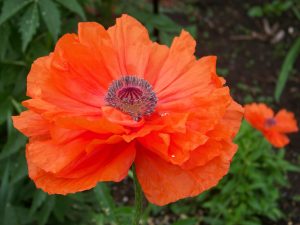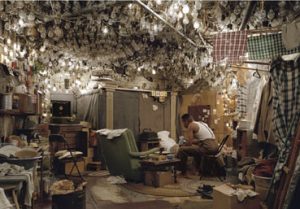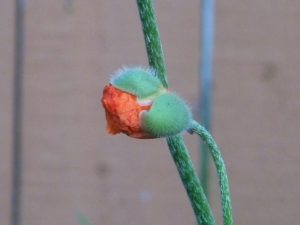I’m here again at last at my desk on a damp gray Sunday morning in which one season ends and another begins, and subtle kinds of fertility are churning despite the overcast sky — I’m feeling the familiar-to-college-professors sense of release from the clutch of preoccupation that marks the school year and a lightening, lifting, and reorienting toward my other lives. After turning in all my grades and bidding farewell to the 2010-2011 academic year this week, I’m settling in for a summer of gardening, teaching summer session and ArtHaus writing classes, revising my novel, and working on several other big writing projects, including the one involving my great-aunt Elizabeth. And thinking, again, about the cycles of growth I’m a part of in ways I never might have known if my life had not put me here, right now, through changes I once never could have anticipated.
Last summer my friend Jill brought me some long, toothy poppy roots in paper bags from her off-the-grid homestead in Allamakee County. Two days ago came a bright-orange crack at the seam of one shaggy pod, then another one — and this morning, the first thing I saw when I looked out the window were the round coral ruffles of the new blooms, floating above the other plants on impossibly narrow stems. Two neat oval halves of the pod lie in the dirt underneath each flower, the obligingly castoff shell of something now gloriously alive.
 Teaching and writing both involve this process, too: watching for the crack of light along a shell, the first dent of the hatchling’s beak from inside, the flash of some new color from inside that whole other thing — that idea, that notion, that person – once so different, even so strange. The challenge is one of attention: holding true in the face of weariness, exasperation, distraction to find that bright seam and help to train the light on it until it cracks open, and then it blooms. But that bright seam is always, already, there.
Teaching and writing both involve this process, too: watching for the crack of light along a shell, the first dent of the hatchling’s beak from inside, the flash of some new color from inside that whole other thing — that idea, that notion, that person – once so different, even so strange. The challenge is one of attention: holding true in the face of weariness, exasperation, distraction to find that bright seam and help to train the light on it until it cracks open, and then it blooms. But that bright seam is always, already, there.
This year I directed two year-long senior honors projects, both subtle and brilliant collections of creative work. One, by R., was a cycle of short stories on the Holocaust. The other, by C., was a collection of nonfiction essays, including an account of his summer teaching at Urban Arts Academy in Minneapolis. Here’s how C. describes the building:
“…the old church which Urban Arts inhabits. It’s an adjoining wing which used to house the parish school. Legend has it that an unassuming jazz legend spent the end of his life and his prodigious career renting the basement of his brother’s house and saved all his money to found the school. I imagine him as a frugal version of Ellison’s Invisible Man, surrounding himself with jazz records, worn and grooved, instead of lightbulbs. Other than music, he puts the rest of his money in a jar under his bed, a hidden man, many things stored away. He endows Urban Arts in his will. The children are like his records, his thousand lightbulbs.”
 (Jeff Wall, “After ‘Invisible Man’ by Ralph Ellison, the Prologue” 1999–2000, http://www.tate.org.uk/modern/exhibitions/jeffwall/rooms/room6.shtm)
(Jeff Wall, “After ‘Invisible Man’ by Ralph Ellison, the Prologue” 1999–2000, http://www.tate.org.uk/modern/exhibitions/jeffwall/rooms/room6.shtm)
C’s phrase, following Ellison’s image of the Invisible Man sequestered in his basement lit with stolen city wattage, is now part of how I think about teaching: students are the thousand lightbulbs, of all shapes and sizes and frequencies, among which I live and work. Each student casts light of a different color – cool blue, vivid green, quiet and steady saffron yellow, gold or purple or red. And like the Invisible Man’s basement room, so much of this life, this light, glows in hidden places, which teachers can’t always see, even as we encourage students forth into the light of shared places too: common spaces of idealism, high standards for conduct and ethics, conversation and thought. And the common space of art, which both depends on and must move beyond the private room with its own dark light.
Senior projects aren’t officially counted in my teaching load but still extremely important: I meet with students, whether semester-long or year-long honors, once every two weeks to read and discuss their work and their progress. Each of my senior-project students this year has produced publishable material – and that’s saying quite a bit. But more importantly, each has embarked on an artistic journey that will carry them on out beyond this college, like an arrow shot from inside a walled garden continues its journey into the air, to land in a place no one can see. This journey involves continued hard work and considerable risk, of a kind many students can’t anticipate. They learn to watch for the idea cracking open, the difficult gap of a personal challenge or change, and to go into the space it makes, despite the risks.
When R. came to me at the beginning of the year and told me she wanted to write a cycle of stories on the Holocaust, I knew it would be hard, but she succeeded. The finished work has not a trace of Schindler’s-List sentimentality, and some unexpected and fruitful moves. For instance, the cycle includes not only a very short glimpse (in Chekhov’s police-report style) of a morning in the life of a female SS guard but a scene drawing on R.’s own actual meeting with the son of a survivor of Cambodian genocide, whose birth – and whose mother – are imagined richly and sympathetically in the concluding story, ending on a fully earned image of life and hope, and linking the survival of humanity through several related kinds of threat. But I think it’s safe to say that although R., an exceptionally skilled and thoughtful craftswoman, knew the risks going in, working on this collection took her to places of darkness even more than she expected, as Nicolson Baker also describes his own Holocaust research. The resulting experience, though, has confirmed for R. something every artist needs to know about herself: she can do serious, sustained work, and although she can find supportive advisors and communities, she can go alone into the places her art takes her, no matter what they are.
Amid final grading, writing recommendation letters for nursing school and for medical school, and watching students walk in graduation — among them many other nurses and future doctors — I wondered, as I always do, where students will go after they leave me. I thought to myself, as I wrote those letters for future nurses and doctors, that I would trust these students with my own life, or someone I loved. This isn’t a bad test of how, and how well, a student has really been educated, no matter what their field: with what can this person now be trusted? What has this person’s education really been about? What kind of person has this become, and how have you helped that evolution?
I am hopeful about these young artists’ futures, and about the futures of so many I watched walk across the graduation stage, circling their names in my program. So many bright cracks of light opening, in the shells of so many college-student selves now ready to be gently cast aside. So many different colors. So many newborn flowers. A thousand lightbulbs.

Love these “bright cracks of light” and so glad you are in a role where you can be such a wonderful source of inspiration to these students. After reading this, I now have confirmed that in 11 years my children MUST go to Luther so they can study with you–forget free will and their right to choose . . . I know what’s best for them (hee hee).
you talk so beautifully about teaching and your hopes for your students. it’s inspiring. *hugs*